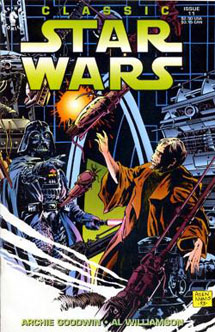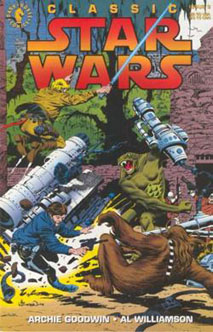Don’t get me wrong; I adore the Archie Goodwin/Al Williamson newspaper strips that were repackaged as the “Classic Star Wars” comics. But I wonder if we never quite saw how good a Goodwin story could be. In the Marvel comics, he was hamstrung by the fact that he didn’t know what was going to happen in “The Empire Strikes Back.” In the newspaper strips, he was able to tie the two movies together, but he was hampered by the format, which — let’s face it — is predicated on shallow, streamlined adventures.
As such, the middle batch of Goodwin/Williamson stories, originally published from 1982-93 and reprinted as “Classic Star Wars” issues 8-14 in 1993, are filled with delicious ideas that Goodwin pokes with his fork rather than feasting on. Even with that caveat, some seem like fully fleshed-out stories, while others seem like filler material — although I don’t see why they had to be that way.
“Traitor’s Gambit” is a prime example of one that feels like filler. We meet new Rebel Silver Fyre, whom Han knew as a backstabbing (albeit sexy) space pirate but whom Leia sees as a valuable ally. This should’ve been an opportunity to dig into the somewhat blind trust that’s needed in a Rebel leader like Leia and how that contrasts with the wariness inherent in Han’s smuggler life. Too quickly, we learn that the traitor of the title is actually Silver’s assistant. The story wraps and we never hear from Silver again, even though her ongoing relationship with Han could’ve been intriguing.

More thought is put into “The Night Beast,” a tense little horror story. A crashed Imperial ship awakens a monster that was left by the Massassi people to guard the Yavin temples until their return. I don’t think this jives with the Massassi as chronicled by Kevin J. Anderson in “Dark Lords of the Sith,” where they were slaves of Exar Kun and were wiped out in a battle with the Jedi. However, that later rewriting is not Goodwin’s fault; “The Night Beast” intriguingly delves into the history of one of the “Star Wars” home worlds, Yavin IV, peppering it with underground tunnels that the connect the various temples. This feature really should’ve been used more often in future stories set on the moon, such as Anderson’s “Jedi Academy Trilogy” and “Young Jedi Knights” books.
“The Return of Ben Kenobi” is a one-note character piece, but a pretty good one. It’d be interesting to know how exactly Vader auditioned people for the role of Ben Kenobi, but I guess that’ll have to be left to our imaginations. As it stands, this actor — and he’s only called “Actor” by Vader, probably because Goodwin didn’t want a newcomer to the strip to think it actually was Kenobi — has a rare experience: Being revered by Luke not for who he is, but for who he’s pretending to be. Luke inadvertently awakens the Actor’s sense of morality. It calls to mind a much better riff on this idea: the “Buffy” episode “Who Are You?,” where Faith becomes a good person by pretending to be a good person. Another fun observation shows that cutting-edge technology stalled as the galactic government switched over: In “The Clone Wars,” Obi-Wan goes undercover by having his face temporarily altered by (incredible) New Republic technology to look like a bounty hunter. Here, the actor has his face altered by Imperial surgeons to look like Kenobi, presumably not temporarily.

In “The Power Gem,” Han and Chewie aim to track down a gem with the power to take down a Super Star Destroyer’s shields. (During this time, the Empire is conducting hit-and-run raids on the Yavin base, but Vader wants to wait for the Executor to be fully completed before he wipes out the base.) A retired pirate will give Han the gem, just so long as he competes and wins in his fight arena. The plot is similar to when Han and Chewbacca had to fight in the Marvel Wheel arc. But it’s interesting to note that Han, the good guy, schemes to steal the power gem from the bad guy, who is actually behaving above-board here; he’s not forcing anyone to fight, after all.
“Iceworld” still has the power of pleasant surprise as Luke and 3PO get caught in a comet’s slipstream and crash land on … Hoth! Luke’s second potential “Classic Star Wars” love interest, Frija, and her father seem to be the entire population of this planet. After Frija and her dad end up dead — and, for somewhat sketchy reasons, turn out to be robots — Luke and the gang decide Hoth could make a decent Rebel base. Interestingly, writer Len Wein apparently didn’t read this story because he wrote his own “discovery of Hoth” yarn in Blackthorne Comics’ “Star Wars 3-D” No. 2, “Havoc on Hoth,” in 1988. I’ll take Goodwin’s yarn because he got there first.
Up next is the weirdly titled “Revenge of the Jedi,” which has very little to do with revenge or Jedis. However, it’s a memorable story because it came out in early 1983 as Goodwin and Williamson were getting their first information on “Return of the Jedi.” They pass on the teasing to fans with the introduction of Admiral Ackbar — he’s a “Jedi” sneak-preview character the same way Boba Fett was before “Empire.” (Fett appeared in a short cartoon in the “Star Wars Holiday Special.”) I like how Goodwin imagines that the Mon Calamari and the Rebel Alliance proper are just starting to join forces against the Empire in this post-“A New Hope” era; it explains why the Mon Cal aren’t around for the Battle of Yavin but are prevalent in the Battle of Endor. Daluuj (Get it? Like “deluge”) is one of Goodwin and Williamson’s best original planets, rife with swamps and monsters and rain and mud — and Imperials! It’s a great place for the Mon Cal to prove their mettle.
In my next flashback post, I’ll push forward to the relentlessly adventurous conclusion of this little corner of the “Star Wars” universe.

